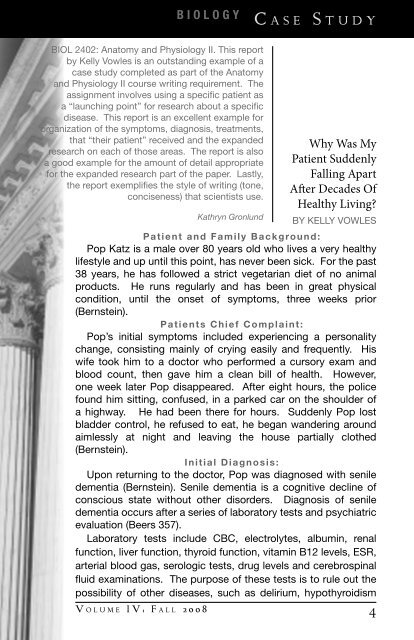2008 - Communication Across the Curriculum (CAC)
2008 - Communication Across the Curriculum (CAC)
2008 - Communication Across the Curriculum (CAC)
Create successful ePaper yourself
Turn your PDF publications into a flip-book with our unique Google optimized e-Paper software.
B i o l o g y<br />
C a s e S t u d y<br />
BIOL 2402: Anatomy and Physiology II. This report<br />
by Kelly Vowles is an outstanding example of a<br />
case study completed as part of <strong>the</strong> Anatomy<br />
and Physiology II course writing requirement. The<br />
assignment involves using a specific patient as<br />
a “launching point” for research about a specific<br />
disease. This report is an excellent example for<br />
organization of <strong>the</strong> symptoms, diagnosis, treatments,<br />
that “<strong>the</strong>ir patient” received and <strong>the</strong> expanded<br />
research on each of those areas. The report is also<br />
a good example for <strong>the</strong> amount of detail appropriate<br />
for <strong>the</strong> expanded research part of <strong>the</strong> paper. Lastly,<br />
<strong>the</strong> report exemplifies <strong>the</strong> style of writing (tone,<br />
conciseness) that scientists use.<br />
Kathryn Gronlund<br />
by Kelly Vowles<br />
Patient and Family Background:<br />
Pop Katz is a male over 80 years old who lives a very healthy<br />
lifestyle and up until this point, has never been sick. For <strong>the</strong> past<br />
38 years, he has followed a strict vegetarian diet of no animal<br />
products. He runs regularly and has been in great physical<br />
condition, until <strong>the</strong> onset of symptoms, three weeks prior<br />
(Bernstein).<br />
Patients Chief Complaint:<br />
Pop’s initial symptoms included experiencing a personality<br />
change, consisting mainly of crying easily and frequently. His<br />
wife took him to a doctor who performed a cursory exam and<br />
blood count, <strong>the</strong>n gave him a clean bill of health. However,<br />
one week later Pop disappeared. After eight hours, <strong>the</strong> police<br />
found him sitting, confused, in a parked car on <strong>the</strong> shoulder of<br />
a highway. He had been <strong>the</strong>re for hours. Suddenly Pop lost<br />
bladder control, he refused to eat, he began wandering around<br />
aimlessly at night and leaving <strong>the</strong> house partially clo<strong>the</strong>d<br />
(Bernstein).<br />
Initial Diagnosis:<br />
Upon returning to <strong>the</strong> doctor, Pop was diagnosed with senile<br />
dementia (Bernstein). Senile dementia is a cognitive decline of<br />
conscious state without o<strong>the</strong>r disorders. Diagnosis of senile<br />
dementia occurs after a series of laboratory tests and psychiatric<br />
evaluation (Beers 357).<br />
Laboratory tests include CBC, electrolytes, albumin, renal<br />
function, liver function, thyroid function, vitamin B12 levels, ESR,<br />
arterial blood gas, serologic tests, drug levels and cerebrospinal<br />
fluid examinations. The purpose of <strong>the</strong>se tests is to rule out <strong>the</strong><br />
possibility of o<strong>the</strong>r diseases, such as delirium, hypothyroidism<br />
V o l u m e I V : F a l l 2 0 0 8<br />
Why Was My<br />
Patient Suddenly<br />
Falling Apart<br />
After Decades Of<br />
Healthy Living<br />
4






